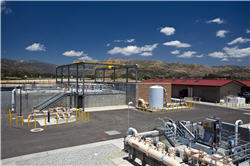A phenomenon first observed by an ancient Greek philosopher 2,300 years ago has become the basis for a new device designed to harvest the enormous amounts of energy wasted as heat each year to produce electricity. The first-of-its-kind "pyroelectric nanogenerator" is the topic of a report in ACS' journal Nano Letters.
A study in the Journal of Hydrometeorology now outlines significant differences of global models and measurement data sets. As the network of measurement stations worldwide is shrinking dramatically, uncertainties are increased.
The use of composite materials is rapidly entering into the automotive industry thanks to a technique developed by the EPFL spin-off EELCEE. This technique promises lighter cars that burn less fuel and, consequently, emit less CO2.
Honeywell, a Fortune 100 technology and manufacturing company, has created a new building management system and Smart Grid Solutions business to help meet facilities' and providers' energy needs.
The American Water Works Association’s 131st Annual Conference and Exposition, also known as ACE12, is flowing smoothly at the Dallas Convention Center. About 2,000 water professionals attended the opening session on June 11.
A Texas Tech University climate scientist said climate change is widely expected to disrupt future fire patterns around the world, with some regions, such as the western United States, seeing more frequent fires within the next 30 years.
New research from Lawrence Berkeley National Laboratory (Berkeley Lab) has found that levels of methane—a potent greenhouse gas emitted from many man-made sources, such as coal mines, landfills and livestock ranches—are at least one-and-a-half times higher in California than previously estimated.
The U.S. Environmental Protection Agency (EPA) has announced a new framework to help local governments meet their Clean Water Act obligations.
U.S. Environmental Protection Agency Regional Administrator Judith A. Enck met on Thursday, June 7, 2012 in New York City with representatives of local governments from Puerto Rico to discuss environmental challenges facing municipal governments in Puerto Rico, and explore solutions.
In an article published in the journal Nature Climate Change, researchers take a critical look at the various factors that have long been prime climate-change suspects. One in particular: The role of population growth.
The recent completion of a $52 million project to rid Roxana Marsh of contaminated sediment will speed the recovery of Indiana’s Grand Calumet River, marking a step forward for one of the Great Lakes’ most complex Area of Concern cleanups.
New groundbreaking research by scientists at Trinity College Dublin has found that exposure to nanoparticles can have a serious impact on health, linking it to rheumatoid arthritis and the development of other serious autoimmune diseases.

Nearly everyone can recall being told to conserve water at some point in our lives…turn off the faucet while brushing your teeth, run the shower only just before entering, don’t wash the car during particularly dry summers. We viewed these directives as minor inconveniences -- the idea of communities experiencing serious water shortages was reserved for developing nations.
The oceans have warmed in the past 50 years, but not by natural events alone. New research shows that the observed ocean warming over the last 50 years is consistent with climate models only if the models include the impacts of observed increases in greenhouse gas during the 20th century.
Vast stores of carbon in U.S. forest soils could be released by rising global temperatures, according to a study by UC Irvine and other researchers in today's online Proceedings of the National Academy of Sciences in Washington, D.C.
Chemical reactions on the surface of metal oxidesare important for applications such as solar cells that convert the sun's energy to electricity. Now scientists have found that a previously unappreciated aspect of those reactions could be key in developing more efficient energy systems.
The EPA said it will approve revisions submitted by the Texas Commission on Environmental Quality to the state’s permitting program for major air pollution sources under the Clean Air Act’s New Source Review (NSR) program.
As landfills overflow with discarded plastics, scientists have been working to produce a biodegradable alternative that will reduce pollution. Now a Tel Aviv University researcher is making environmentally friendly plastics tougher than ever before.
University of Tennessee researchers have successfully developed a key technology in developing an experimental reactor that can demonstrate the feasibility of fusion energy for the power grid.
A commentary published today in GCB Bioenergy reveals that calculations of greenhouse gas (GHGs) emissions from bioenergy production are neglecting crucial information that has led to the overestimation of the benefits of biofuels compared to fossil fuels.